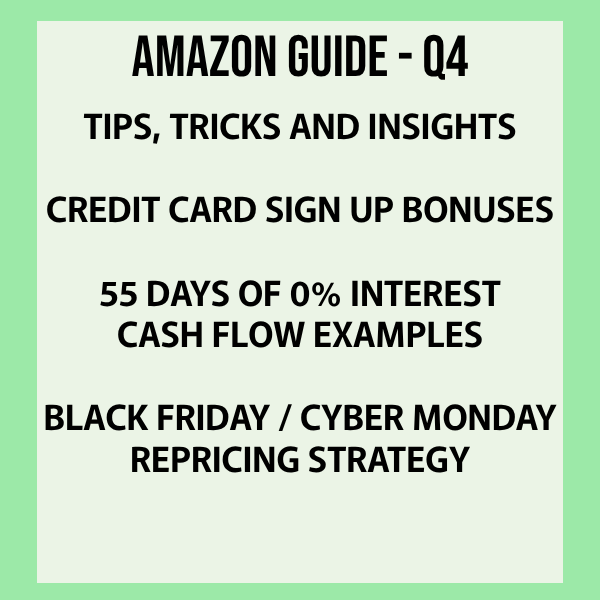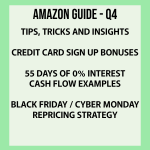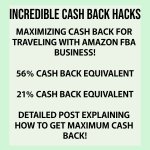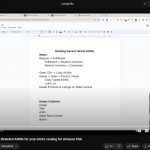Guide – 2025 Q4 Tips, Tricks and Insights
Here are some insights for newer sellers for their first Q4 from the perspective of a 100% FBA + OA + Prep center Amazon seller with lifetime sales of over 7 million since 2014.
Credit Card Sign Up Bonuses –
Now is the best time to hit credit card sign up bonuses from spending if you haven’t signed up for anything yet.
Cash back as a dual purpose –
November and December will be full of elevated cash back days. This means you’re likely to see 10% cash back or higher on websites multiple times till the end of the year. This will put you in a position of strength in 2 different ways:
1- I like to think of cash back as my last line of defense against price tanking. I’m of the belief that margin vanishes in this order: Sale price difference -> Sales tax -> Gift Card -> Cash Back.
If an item cost goes from $100 to $85, that $15 margin will be the first thing to evaporate.
Sellers will generally park themselves at break even when they want to exit. I’ve noticed you can kind of tell which sellers are paying sales tax depending on where they park their price. This is why buying tax exempt or using a prep center to avoid sales tax can be a competitive advantage as it will give you anywhere from 5-10% extra breathing room on margin.
Gift card purchases will be the next line of defense. Buying a $100 gift card for $90 gives an extra 10% of wiggle room to absorb price movement.
Cash back is going to be the last line of defense to absorb any losses, the more you have the better. I do not factor cash back into my costs. From what I understand (I’m not a tax person), its considered a rebate and not taxable. I like to think of it as a bonus if everything goes well. If it doesn’t go well, then I consider it off setting the loss.
Only after it’s pierced through those 4 layers and ONLY then do you start to APPROACH taking a loss, it has to continue to go down that much further on top of losing its original margin.
You can mitigate price tanking more based on your ability as a buyer via what I call qualifying leads into purchasing, if you want more info on this, poke me as that’s a separate write up!
2 – Getting paid out in Amex points instead of cash back on Rakuten.
If you have any credit card that earns Amex points, you can link your Rakuten account and get paid out in Amex points instead.
Why is this so powerful?
2 reasons:
- You can earn points 10x faster than someone trying to earn points on a credit card alone. Example, general credit card spend might earn 1 Amex point per $1 spent. Whereas, a 10% cash back day will pay out 10 Amex points per $1 spent. Meaning, you can earn 10x the points for 1/10th the effort as the credit card person.
- You can redeem those points into lopsided redemptions. Example, I was able to book 2x business class flights to Nova Scotia for 78600 Amex points that would have cost $4000 in cash to book. On a 10% cash back day, I would have needed to spend $7860 to earn 78600 Amex points. That means the flight was functionally 50% cash back equivalent. $4000 cash value / $7860 spend needed to get it.
So in practice, even if the near $8,000 in inventory broke even, I would still have made 50% ROI equivalent on the flight redemption. Knowing this, I am VERY open to buying high velocity / low margin items and use them as a vehicle to farm massive amounts of points on since I know my cash back equivalent will likely be over 30% on the points redemption.
First in Vs Last out:
First in – If you’re able to FBM and can be first to market you can take advantage of higher margins before the ASIN has had a chance to adjust to the new lower cost. Your competitive advantage here is speed.
Example – If something historically costs $50 and sells for $100 and goes on sale for $35, that $100 selling price will exist until more and more of the $35 inventory makes its way on to the listing. In this case there’s $15 more margin to be had and I generally anticipate the listings selling price to come down by that same amount, using the same example, the selling price would go from $100 to $85. Some sale items that are on page 1 of a sale, I consider them “magnets” that attract sellers due to the high margin which will drive in tons of supply and put downward pressure on price and erode the margin.
For FBA this is going to be tricky to handle because the environment you’re reviewing it in (day 1) isn’t the same environment you’re going to land in when the item fully checks in (anywhere from 1 week or longer if you’re lucky). Then you may be forced to make the judgment call of holding but the question becomes how long. This is where being on higher velocity listings helps. Example if the listing sells 100 units a month and there is about 25 quantity before it turns profitable, you can try waiting 1 week for that 25 quantity to sell through and then price around there.
Last Out –
In a perfect world, the ASIN resets back to its historical average and you’re the last seller with black Friday cost. The problem with this method is, there is no way of knowing how long that will take, if it happens at all. The listing price can continue to stay the same or even get worse. The problem here is opportunity cost in the form of having capital tied up in something that could otherwise be compounding. However, when it does work, it works EXTREMELY well. The other problem is, you’re not going to be able to replenish any of the inventory at that cost. This can kind of be remedied by buying deeper but again, the hold period is the variable that you’ll live and die by. High velocity ASINs help chew through quantity getting rid of people’s black Friday inventory.
55 days of 0% interest cash flow –
This works best if you have 4 credit cards and you call your credit cards and stagger your statement balance date. The short story is, you want to put a majority of your spend on the 1st date of your statement cycle and it wont be due till basically the 3rd cycle.
Example –
Billing Cycle = Jan 28th, 2022 to Feb 24th, 2022 = 28 days
Due Date = March 21st, 2022
That means the charges from Jan 28th won’t be due till March 21st 2022.
In order to avoid paying interest, you need to pay the statement balance in full by the due date. The goal here is to hold onto the credit cards money as long as possible before paying it back. The hope being, you’ll be able to compound it.
This method is made more powerful if you have 4 credit cards and stagger the billing cycle every 7 days and you switch credit cards every 7 days. The byproduct of this is, you’re trying to spread the full balance across 4 cards now instead of 1. Example – $10,000 vs $2,500 per card. This ends up being helpful due to the 2 week disbursement cycle (if you’re not doing daily payouts). Its easier to pay off a $2,500 statement balance than a $10,000 one. Also, if you’re unable to pay off the statement balance, its better to eat the interest on a $2,500 balance than a $10,000 one.
Stock outs –
From a competitive advantage standpoint, if you’re ever able to stock out something online, think of it as stocking it out to the entire USA. This means you functionally cut off supply from entering the ASIN. This is a VERY powerful position to be in as it means less downward pressure on the listing via more supply. The problem here is, there is no way of knowing if the item will restock.
Restock Monitors –
Make use of websites like distill.io to monitor sites for restocks or price changes so you can be the first one to capture them. It’s like actively looking but passively!
Black Friday deals –
If you’re using any kind of automation or software, you’ll probably miss out on a lot of black Friday deals.
Example – If something is normally $50 and goes on sale for $25, what will likely happen is Amazon will price match the $25 or if the manufacturer is selling on Amazon, will also price match and sell at $25. The problem is, software will see it on say Target for $25 and calculate the profit based off the $25 listing price and deem it not profitable.
This is where product knowledge comes into play because what will likely happen is, once black Friday is over, the price will go back up to $50. That $25 black Friday cost will not sustain and it’s a one time event. This is where checking the historical data on the ASIN will tell you where it likes to rest historically. At the time of purchase it will look like a loss, but after the sale ends it will make sense.
Why is black Friday so good?
Whenever an item is purchased, the worry is always, what if it just goes on sale again next week and for a lower price? Black Friday should be the lowest possible price throughout the year, which means you shouldn’t have to worry about anyone coming in at a lower price after. Which also opens the possibility of buying deeper than normal (if you can get the quantity). I’m talking about buying 2,3,4+ months of supply provided the demand is consistent on the listing. I will happily tie up capital for an extended period of time if it means 40/50/60% ROI+. Make sure to do your due diligence if you take this route.
Inventory for Q1:
If you’re mainly doing FBA (like me), most of your black Friday purchases will likely not check in time for Q4. I approach this as a bonus if it does, if it doesn’t, that just means my Q1 inventory is at Black Friday prices.
Repricing:
Amazon places A LOT of weight on delivery speed during Q4. Meaning they’ll favor the fastest seller over the cheapest one. We can take advantage of this premium.
You’ll want to review all of your listings and see how much quantity there is before any price jumps (if any) and park there. Example, 4 quantity at $50 then it jumps to $56. If I estimate it might take 3 days for the 4 quantity to stock out, I’ll wait it out and park at $56.
Make sure to check delivery times when you’re repricing against other sellers. Using the $50 example above, you don’t want to price against a $45 seller back ordered for 3 weeks when everyone in stock is at $56.
It’s not a bad idea to check your repricing everyday. If something is selling to fast, try raising the price to squeeze out more margin per sale. If you go to high, sales will slow down entirely. It ends up being a balancing act!
Black Friday / Cyber Monday Repricing:
Since I send everything in FBA, I don’t have the luxury of restocking in time for Q4. So it turns more into a game of maximizing what I have in stock. What this means is, I’ll intentionally price many of my ASINs high with no intention to sell on Black Friday or Cyber Monday.
Why?
I like to think of it this way, those two days will be the first assault wave of demand on supply and all the low priced sellers will be the first to fall and exit the listing. The listing will have less supply as a result and hopefully higher prices.
This isn’t a one size fits all strategy, it works better on ASINs that have shallow quantity before price jumps occur. Do this on a case by case basis.
The other needle you’re trying to thread is balancing your inventory. The north star I’m trying to achieve is stocking out as much inventory as I can by the end of the year. I like to think of it as my business stocking out of Q3 inventory in Q4 so I can start Q1 with Q4 cost. If you time it wrong, you may be left holding inventory when Q4 ends and the demand will drop off and everything will take longer to sell.
Losses:
I have a saying; all of my failures get cleansed in Q4. I LOVE selling things at a loss during Q4. Why? Since I should be running at a higher profit due to Q4, I think of it as absorbing my losses and lowering my tax burden and resetting myself back into cash on my bad purchases. It’s like spring cleaning but during q4!
Gains:
If you’ve made lots of profit from Q4, you’re going to want to do tax write offs to lower your tax burden! For me this means, buying yearly subscriptions to save, buying courses/mentorships/supplies, or making 401k SEP IRA contributions!
Returnuary (January) –
Amazon offers extended returns usually till about the end of January. Make sure you don’t spend all your profit from December thinking you’re in the clear. Keep some of it in reserve as you’ll have to offset returns/refunds etc.
Lego Purchasers:
If you like doing buy and hold plays, Lego ends up being a good vehicle to do that. In general, Lego usually produces sets for about 2 years and then it discontinues forever. In essence what you’re trying to do is buy around 90-99% into its life cycle so you reduce your hold time. Then wait 6-12 months for existing supply in the market to sell out and prices to go up and then start selling.
The problem is, accurately timing the life cycle. I’ve seen Lego sets stock out early 18 months into their life cycle or as late as 30 months. If you miss time it, you miss out getting supply OR you end up holding longer.
What ends up happening during Q4 is retailers will usually heavily discount end of life sets to make shelf space for the new sets. All the elevated demand from Q4 will help sell through existing supplies and with no more supply it ends up creating a perfect squeeze. This makes for a very powerful entry point. You’ll enter at the lowest price point possible and hold for the shortest period possible if timed to perfection.
This is general overview of Lego and there’s more nuance that goes into it, as certain Lego sets are more prone to appreciate better than others. But if you time it right, it’s not uncommon to achieve 75% ROI or more. The other problem you’ll create in the process is having to store it in the meantime and having no cash flow while you hold. But the trade off is, you can sell less items to produce the same level of profit. Example, 1x sale at 75% ROI versus 3x sales at 25% ROI each.
That does it for my 1 hour of writing time LOL. If there are any other tips you’d like to share with other sellers, I’d love to learn from your experiences too!






Leave a Reply